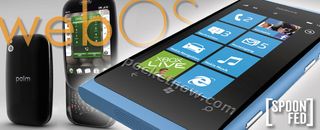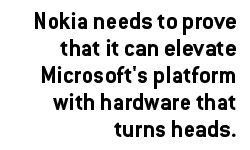Nokia's Palm Moment Has Arrived

Back in 2009 it was called a Hail Mary pass, a last-ditch attempt for a once-dominating smartphone maker to remain relevant in an iPhone and Android world. I'm referring to the introduction of the Palm Pre running webOS. That pass kept Palm in the game, but it ultimately lost to Apple and Google (even with HP's "help"). Now Nokia finds itself at a similar juncture, having lost 66 percent of its market value since 2007. Except this time the underdog is still the largest cellphone maker in the world--and it has Microsoft on its team.
This is Nokia's Palm moment, but there's even more on the line.
At Nokia World in London tomorrow, the company will unveil its first handsets running Windows Phone 7.5 (Mango). I liked using the software during my review, especially the Groups and improved multitasking, but there was something all-too-familiar about the experience. I was using the same Samsung Focus that launched a year ago. I concluded by saying that Windows Phone had "improved to the point where all it needs is great new hardware to really make it sing." Enter Nokia, world-renowned for its first-class hardware design.
In some ways, webOS and Windows Phone are similar, in that people who use the software enjoy it. But they're also similar because consumers have complained about the lackluster hardware. The original Palm Pre felt a little cheap and sluggish by the time it reached the market, and follow-up devices fell flat. On the Windows Phone side, the designs have been uninspired, and their specs have trailed the Android competition. Nokia needs to prove that it can elevate Microsoft's platform with hardware that turns heads.
Although Nokia isn't the only company debuting Windows Phone Mango devices this fall, none of the handsets I've seen thus far really wow. The new new $99 HTC Radar 4G for T-Mobile is sleek but looks underpowered compared to the iPhone 4 and similarly priced Droids. And while the monster-sized screen on the 4.7-inch HTC Titan will definitely stand out on the shelf, its resolution (800 x 480 pixels) pales in comparison to the upcoming 4.7-inch Samsung Galaxy Nexus (1280 x 720). Samsung's new round of Focus devices have beefed-up specs but don't look much different than last year's slabs.

So how can Nokia make Windows Phone exciting? According to leaked information, the company will announce a trio of devices. Modeled after the gorgeous N9, the Nokia Lumia 800 (aka Searay) is expected to sport a curved 3.7-inch display, an 8-MP camera with Carl Zeiss optics, and three color options: black, blue, and pink. A second lower-end model called the Lumia 710 (codenamed Sabre) apparently looks more like the iPhone, and will come in white with a 5-MP camera. It's also expected to feature mechanical buttons instead of capacitive ones, which many shoppers prefer.
Last but not least is the Ace, which according to reports will be Nokia's top-of-the-line model (though it may not be officially announced tomorrow). Expected features include a large 4.3-inch Super AMOLED screen, a 1.4-GHz processor, and an 8-MP shooter with Carl Zeiss optics. The Ace will also boast a slide-out keyboard, which could entice business users and heavy texters alike.
Stay in the know with Laptop Mag
Get our in-depth reviews, helpful tips, great deals, and the biggest news stories delivered to your inbox.
Those three phones look like they should be able to compete in their respective price categories, but it's not clear whether these phones will be good enough to make Nokia relevant in the U.S. again. Jo Harlow, the Nokia's executive vice president of smart devices, seemed to be managing expectations when she told The Wall Street Journal that the company's devices won't differ greatly from others on the market. However, she said Nokia's Windows Phones will include some of Nokia's own technlology, such as its mapping applications, which I hope means free spoken GPS navigation.
Another critical piece to the puzzle is how Nokia plans to market its Windows Phones. Palm completely threw consumers for a loop with its odd, new age-y campaign for the Pre. And Microsoft's "Really?" ads for its platform last year were almost as bad, telling people why they shouldn't use competitors phones so much instead of telling them why they might want a Windows Phone. According to Advertising Age, the campaign will center around the idea of "Amazing Everyday." The message: "Hidden away in the everyday landscape are billions of little adventures. And the new Nokia with Windows Phone makes it easier to find them, to take part in them and to share them."
The piece goes on to claim that Nokia could miss the critical holiday selling season in the U.S., because it needs to regain momentum lost in Europe first. I'm not sure Nokia can afford to wait much longer, not when the iPhone 4S and Galaxy S II are ringing up sales left and right.
One thing's for sure. Nokia's new Windows Phones better amaze. Or both the phone maker and Microsoft's platform will wind up like Palm and webOS.
